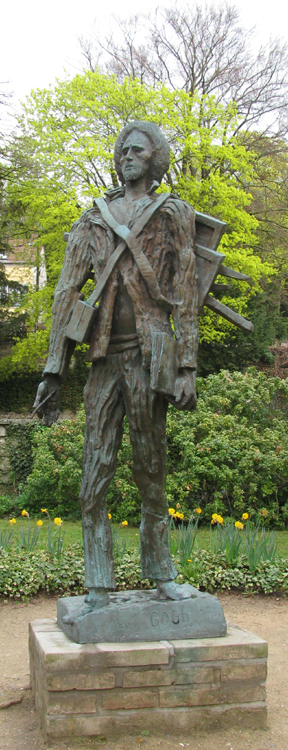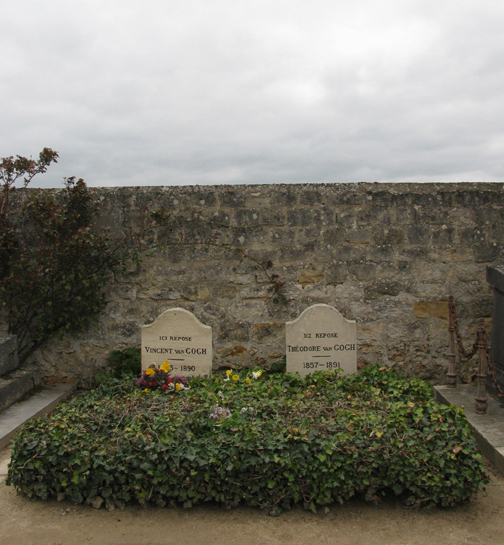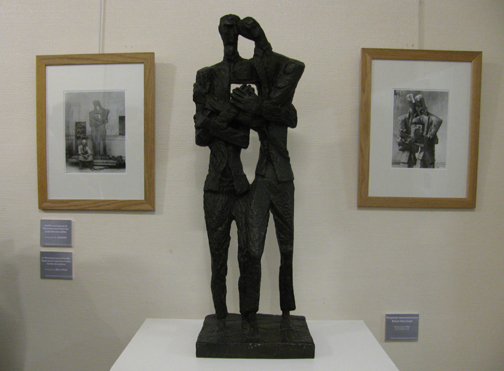
“There’s nothing to see here,” he says before we enter room #5 at the Auberge Ravoux, the inn where Vincent Van Gogh lived and died at Auvers-sur-Oise, 18 miles northwest of Paris.
“There’s nothing to see here, but people still want to come,” he says.
He is Dominique-Charles Janssens, proprietor of the Auberge Ravoux, which now functions not as an inn but as a placeholder for the memory of Vincent Van Gogh. Mr. Janssens is also director of the Institut Van Gogh whose goal for for the past two decades has been to purchase a painting by Van Gogh to hang in this tiny attic room since the artist once wrote that he dreamt of having an exhibition in a café.
“There’s nothing to see,” he says, “but everything to feel.”

Yet I don’t feel much. If his room wasn’t such a tourist attraction would I be more inclined to feel the artist’s presence, his poverty, his mix of hope and despair in the final, prolific 70 days of his life?
I was here about 20 years ago, when there was a bit less to see and a bit more to feel but still didn’t feel much. Has revisiting dampened my interested in the subject? No, I was rereading Van Gogh’s letters to his younger brother Theo the other day and found them just as fascinating as when I first read them in my 20s.
Perhaps Mr. Janssens, a former marketing director with the Danone group, who purchased the inn 25 years ago, has given this presentation a few too many times and I’m overly aware that the “nothing to see but everything to feel” line is in the brochures.
There is nothing to see in Van Gogh’s room other than a small skylight, an old bistro chair, and a secure wall awaiting the painting. A 13-minute video about the artist is shown two rooms away.

I’m not disappointed, though, just ready to move on. I actually like the feel downstairs of the old bistro/café circa 1890 where we had coffee and a crossant. There was something to see there, some atmosphere to feel, a cup of coffee where Vincent had dinner.
Anyway, it isn’t for Van Gogh alone that I’ve come to Auvers-sur-Oise this time. It’s for Zadkine.
This summer Auvers-sur-Oise celebrates the 50th anniversary of the inauguration in town of a bronze statue of Vincent Van Gogh by the sculptor Ossip Zadkine (1890-1867).
Zadkine’s name may have been mislaid among the hit-parade of artists and sculptors who made their mark in Paris in the 20th century, yet his work has maintained its strength and depth and originality. The Zadkine Museum near the Luxembourg Garden, where the Russian emigree lived and worked from 1928 until his death, is a personal favorite of mine among the small museums of Paris.
Why Auvers
Daubigny, Corot, Cézanne, Pissarro, Vlaminck and others contributed to placing Auvers and surroundings on the map for the Impressionists and their kin both pre- and post. Daubigny is the least bankable of the names above, but it’s largely thanks to him that Auvers, where he lived from 1861 until his death in 1878, became known as an Impressionist hang-out. But it was Van Gogh, the least successful of these during his lifetime, who, in creating 70 paintings in 70 days and in dying here two days after shooting himself in the stomach, gave Auvers its lettres de noblesse as an art town.
We all now recognize the work he did during this final, prolific period of his life: his portraits (e.g. Doctor Gachet, Madame Gachet, self-portrait) and landscapes (e.g. the wheat field with crows) and views of Auvers’ major buildings (e.g. the church, town hall, the chateau). Nineteen plaques have been placed around Auvers with weathered reproductions showing where he mostly likely stood while painting the given view.
Across the street from the inn, Van Gogh painted the little town hall decorated for the 14th of July (Bastille Day) Ball; in the evening the square would be full of people, a brass band playing, the whole town dancing, laughing, drinking. But as he paints there is no one to be seen.
He painted the town’s church, wobbly in the evening nightfall, at the end of a lush, green day, a peasant woman walking by.

Van Gogh arrived in Auvers on May 20, 1890, and died on July 29 in that room where there’s nothing to see at the Auberge Ravoux. He was 37. His younger brother, confidant, and primary supporter Theo died of syphilis six months later. He was 33. There isn’t much to see at their plots in the cemetery, just two simple rounded tombstones, pillows on a single ivy-covered bed, but that’s enough to make you want to go home and read Vincent’s collected letters (primarily to Theo).

Beyond the wall of the cemetery is a field, where Van Gogh saw crows. He shot himself in such a field.
Why Zadkine
Local admirers of Van Gogh selected Zadkine for the commission of creating a statue to the artist in 1955. Zadkine’s Van Gogh stands in a non-descript park, a simple public green space where otherwise you’d scarcely want to stop on your way to the market. It shows a tall, thin figure, his hatch-marked face tense and focused, marching into the sun with his easel and paint utensils slung along across his chest and back. Zadkine described him as “an escaped prisoner who has left with his bars.”
Subsequent to the inauguration of his Van Gogh here in 1961, Zadkine received two other commissions for sculptures in places associated with the artist:
– a sculpture of Vincent and his brother Theo that stands in the Dutch village of Zudent, his birthplace;
– a bust of the artist that can be seen at the asylum at Saint Remy de Provence where Vincent interred himself from May 1889 to May 1890 following a troubled winter during which, after a fight with Gaugin, he cut off his earlobe and offered it to a prostitute.

From Saint Remy, Van Gogh returned to Paris then moved to Auvers, already known to his contemporaries and elders as a peaceable painter’s town. There was countryside here, and the Oise River passes by. Also, Dr. Gachet, who would watch over Van Gogh during his stay, lived here. Van Gogh’s portrait of Dr. Gachet is among the artist’s works at the Orsay Museum; it was a gift to the State by the doctor’s son. Dr. Gachet’s house is also being used to honor Zadkine this summer with a presentation of 19 lithographs.
Far more notable is the selection of sculptures, on loan through August 31 from the Zadkine Museum, that are exhibited in the Orangerie of the 17th-century Chateau d’Auvers. The selection shows the variety of Zadkine’s work from 1926 to 1963.
Another venue for Zadkine’s work this year is the Musee Daubigny, which is showing various sculptures and photographs relative to the creation and installation of his statue of Van Gogh. They give insights into the sculptor’s efforts to create a work honoring a fellow artist. It’s a small but worthwhile exhibit that includes a video showing Zadkine riding from Paris on the bed of a truck with his Van Gogh on the way to Auvers—quite amusing actually, the sculptor looking like a proud tourist as he rides along the Seine, past the Louvre.
On May 21, 1890, the day after Vincent’s arrival in Auvers, he wrote to his dear brother in what may have been a rather manic moment and lauded the beauty of Auvers’ thatch roofs and picturesque countryside.
But Auvers isn’t beautiful anymore, and probably hasn’t been for some time. It isn’t beautiful, it isn’t easy to get to, and there’s isn’t much to see at the inn, but there’s a lot to discover here… and possibly to feel. That’s up to you.
(c) 2011, Gary Lee Kraut

If you go
Zadkine in Auvers. Zadkine’s statue of Van Gogh is a permanent presence in Auvers. Zadkine’s works elsewhere in town are only on display April 2-Aug. 31, 2011.
Auberge Ravoux/Maison de Van Gogh (pronounced von gog in French), Place de la Mairie, 95439 Auvers-sur-Oise. Tel 01 30 36 60 60. Open early March to end October, Wed. to Sun., 10am-6pm. Entrance: 6€. Visit to room + 13-minute video + explanatory panels. During those months the dining room serves lunch Wed.-Sun. and dinner Sat. and Sun.
Auberge Ravoux, the original inn, has been restored as it would have been in 1890, though much of the meal space is in a new construction behind the inn. (At the time of Zadkine’s commission the inn where his admirers gathered bore the name Restaurant Van Gogh before reverting to Auberge Ravoux.)
The Chateau d’Auvers houses a permanent multimedia show that seeks to bring to life the art and leisure of the Impressionist period. There’s a café inside. Entrance: 13€.
The Zadkine exhibition is in the Orangerie, a separate entrance from the chateau. Entrance: 3€.
The Auvers-sur-Oise Tourist Office is located in the Manoir des Columbières, rue de la Sansonne. Tel. 01 30 36 10 06. Various tourist information can be found on the town’s website.
Musée Daubigny, within the building that houses the tourist office, is open afternoons Wed-Sun. as well as 10:30am-12:30pm Sat. and Sun. April-Oct. Entrance: 4€.
The Auvers-sur-Oise International Music Festival
An annual event bringing classical music to town from early June to early July (June 4-July 7, 2011).
Getting to Auvers
Access to Auvers from Paris by public transportation can be complicated since it consists of taking the train from Paris’s Gare Saint-Lazare to the town of Pontoise then changing trains for Auvers. Alternatively, take the train from Gare du Nord to Valmondois then change trains for Auvers. The trip takes about an hour with a decent connection. Or taxi from Pontoise (6 miles) or Valmondois (3 miles). Check the train schedule on any given day here.
On Satudays, Sundays and holidays from April through October, there is a direct 33-minute train from Paris Gare du Nord to Auvers departing Paris at 9:56am. The return train departs Auvers at 6:15pm, meaning that you’d be required to make a day of it. One could, I suppose, but I suspect that I’d find myself waiting around for the train. Furthermore, the Auberge Ravoux recommends avoiding weekends, if possible, due to crowds since only small groups are allowed into Van Gogh’s room at any one time.
Staying in Paris
Musée Zadkine, 100 bis rue d’Assas, 6th arrondissement. Metro Notre-Dame-des-Champs or Vavin. Closed Monday and most holidays.
(c) 2011, Gary Lee Kraut


I couldnt disagree more. Modern-day Auvers is an extraordinarily beautiful place, and setting foot into Vincent’s room at the Ravoux was one of the more poignant moments of my life. I am sorry you didn’t feel it as I did and as thousands of others have.
Mr. Kraut, I found some of your observations puzzling. I was in Auvers in October, and found it a beautiful place. Quiet lanes, charming old houses, fields nearby, and long views of the river valley. I’ll agree it isn’t easy to get to, esp. during the week (when there isn’t a direct train). And, we went on a Monday, so unfortunately the visitor center, Ravoux inn, Dr. Gachet house, and absinth museum were all closed. But I am still glad we went.
Patrick. Thanks for your comments. Auvers certainly does have its charms, as you describe. I wouldn’t discourage anyone from going to discover the town and the Van Gogh sights for himself. The question I was addressing in the first part of the article was whether or not I “felt” Van Gogh’s presence in his attic room. I didn’t on that visit. Others react differently. There’s no right or wrong here. Gary